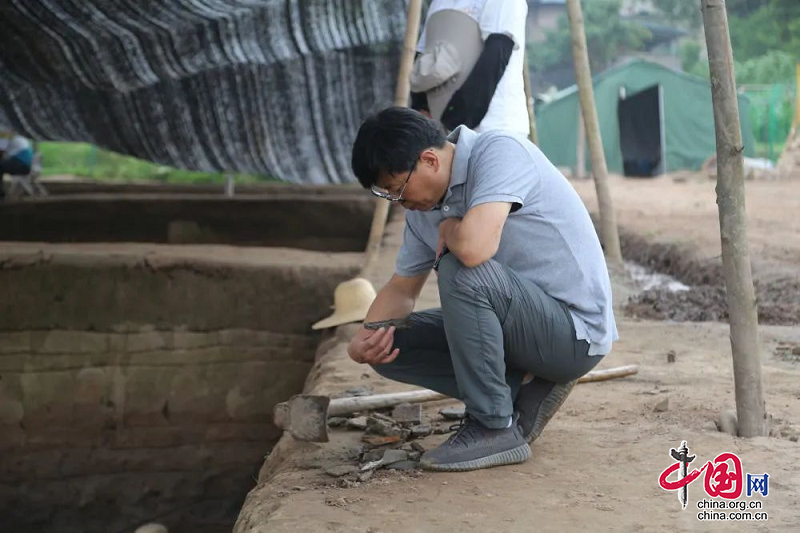With tortuousness of the Yangtze River and vastness of Bayu land,the mountains and waters in the east of the Sichuan Basin gave birth to the ancient Ba civilization that is interconnected with the ancient Shu civilization.The Chengba Site known as the"Dangqu City"is the last heritage of the ancient Ba Kingdom.In the past two decades,archaeologists have been working in obscurity on this mythological land and gradually represented the history of the ancient Ba Kingdom and rediscovered the mysteries of the Ba culture.

Aerial photo of Chengba Site
The Chengba Site in Quxian County is the most culturally enriched ancient city site of Han and Jin Dynasties with oldest and longest history discovered so far in eastern Sichuan.Located on the left bank of the Qujiang River in Chengba Village,Tuxi Town,Quxian County,Dazhou City,Sichuan Province,with a total area 5.6 million square meters,the Chengba site presents a water-surrounded and mountain-backed landscape.
According to Chen Weidong,researcher at Sichuan Provincial Institute of Cultural Relics and Chengba Site archaeology work team leader,after Qin Kingdom unified the six kingdoms,a locality named Dang Qu Dao was established in this land to manage the ethnic group named Cong.In the early years of the Western Han Dynasty,thanks to the contributions of the Cong ethnic group in helping the founding father of Han Dynasty Liu Bang defeat the three generals of Qin Dynasty,the locality was pardoned from taxation and promoted to County from Dao.In the mid to late Eastern Han Dynasty,Feng Ting known as Chariots and Cavalry General of Dangqu County expanded the city that was named as"Chariot and Cavalry City".During the Eastern Jin Dynasty,with the"Chenghan"regime established by Li Xiong and Li Shou,especially after the Li Shou Rebellion,due to occupation by wicked invaders,the county locality was abolished and the grand Dangqu City started to decline.

Chen Weidong observing the unearthed pottery fragments at the archaeological excavation site of Chengba Site,May 2023
It is understood that the archaeological work at the Chengba Site began in the 1980s when local villagers discovered a large number of bronze artifacts during excavation for building brick kilns.Since 2014,the Sichuan Provincial Institute of Cultural Relics and Archaeology has collaborated with relevant departments to carry out excavations at the Chengba Site in Quxian County,Sichuan.This year is the tenth year since the archaeological team was first inaugurated at the Chengba Site,where tombs,smelting relics,city walls,granaries,roads,etc.have been discovered,and large quantity of bronze ware and bamboo and wooden slips that feature Ba culture have been unearthed.In particular,noteworthy is a large number of tiles with"Dangqu"scripts were unearthed in the city site area,proving that this place is indeed the seat of"Dangqu City"documented in historical archives.

The tiles with"Dangqu"scripts unearthed in the Chengba Site
The'Dangqu City'site showcased the 800 plus years history of the rise and fall of an ancient city,which was the important period when the integration of Ba culture into Chinese national culture had occurred.It provides not only a model of ancient city site research to understand their development and evolution in the Chinese history,also a testament of cultural integration and diversification of the Chinese nation,"said Chen Weidong.
In recent years,the system of archaeology in China has gradually improved,and the archaeological work at the Chengba Site is also undergoing continuous transformation.The Archaeological Team of Chengba Site of Sichuan Provincial Institute of Cultural Relics and Archaeology,in cooperation with the Archaeological Research Institute of the Chinese Academy of Social Sciences,Palace Museum,Peking University,University of Science and Technology Beijing,Sichuan University,Shandong University,Southwest Minzu University and other universities and research institutes,has carried out research on numerous topics,such as biological anthropology,animal and plant archaeology and life and business forms,metallurgical archaeology,restoration and protection of metal relics,Ba and Shu symbols,unearthed tiles and architectural structures,and delivered a series of major results.
Among them,the cooperation with Shandong University has interpreted the ancient environment and life and business forms of the Chengba Site,and discovered that the mixed farming mode of millet with dry rice had formed,which confirms the record in the Chronicles of Huayang,which noted"farmland is in the plain and crops farmed are mostly millet".The ancient Ba People long lived in the Ba and Yu region that features mountains and waters,and focused on collecting,fishing and hunting,and primitive farming activities since ancient times.
The joint archaeological research with Sichuan University in the smelting area redefined our previous understanding of the functional zoning of the Chengba Site.The discovery of blast pipes,slag smelting,forging pieces,ironware,and forging furnaces has confirmed the records of"Ironware of Dangqu"and"Ironware Officials of Dangqu"in historical literature,and confirmed the development process of the southwest frontier ethnic group's integration into the national system of China during the Han and Jin dynasties from the perspective of ironware production.

The Shelter of Protection in Chengba Site Area
The deeper archaeological research demonstrated the increasingly prominent importance of the Chengba Site.In 2006,the Chengba Site was named by the State Council as a Major Historical and Cultural Site Protected at the National Level.In October 2016,the Chengba Site was listed as a Grand National Heritage Site by the National Cultural Heritage Administration.In 2018,the archaeological findings at the Chengba Site in Quxian was awarded the first prize for field archaeological work by the Chinese Archaeological Society.In December 2022,Quxian Chengba Archaeological Site Park was enlisted among the fourth batch of national archaeological park projects of China.
According to Chen Weidong,the Chengba Sitearchaeological team is currently carrying out organized social education activities on the Site,telling the public such as villagers and school students its"legendary stories from ancient times to present".The local government is also active in advancing the construction of the Chengba Site Museum and Archaeological Site Park in a bid to showcase the archaeological achievements on the Chengba Site in various forms,and achieve seamless integration of archaeological site,museum,natural landscape and ecological agriculture to recreate the wonderland of the Han Dynasty and present an original"Dangqu City"to the public.
“We will continue to carry out in-depth work on the Chengba Site,share more archaeological achievements with the public,and continuously strengthen the protection and utilization of cultural relics,strengthening cultural confidence,"Chen Weidong said.
(The End)(Photos by Sichuan Provincial Institute of Cultural Relics and Archaeology)





